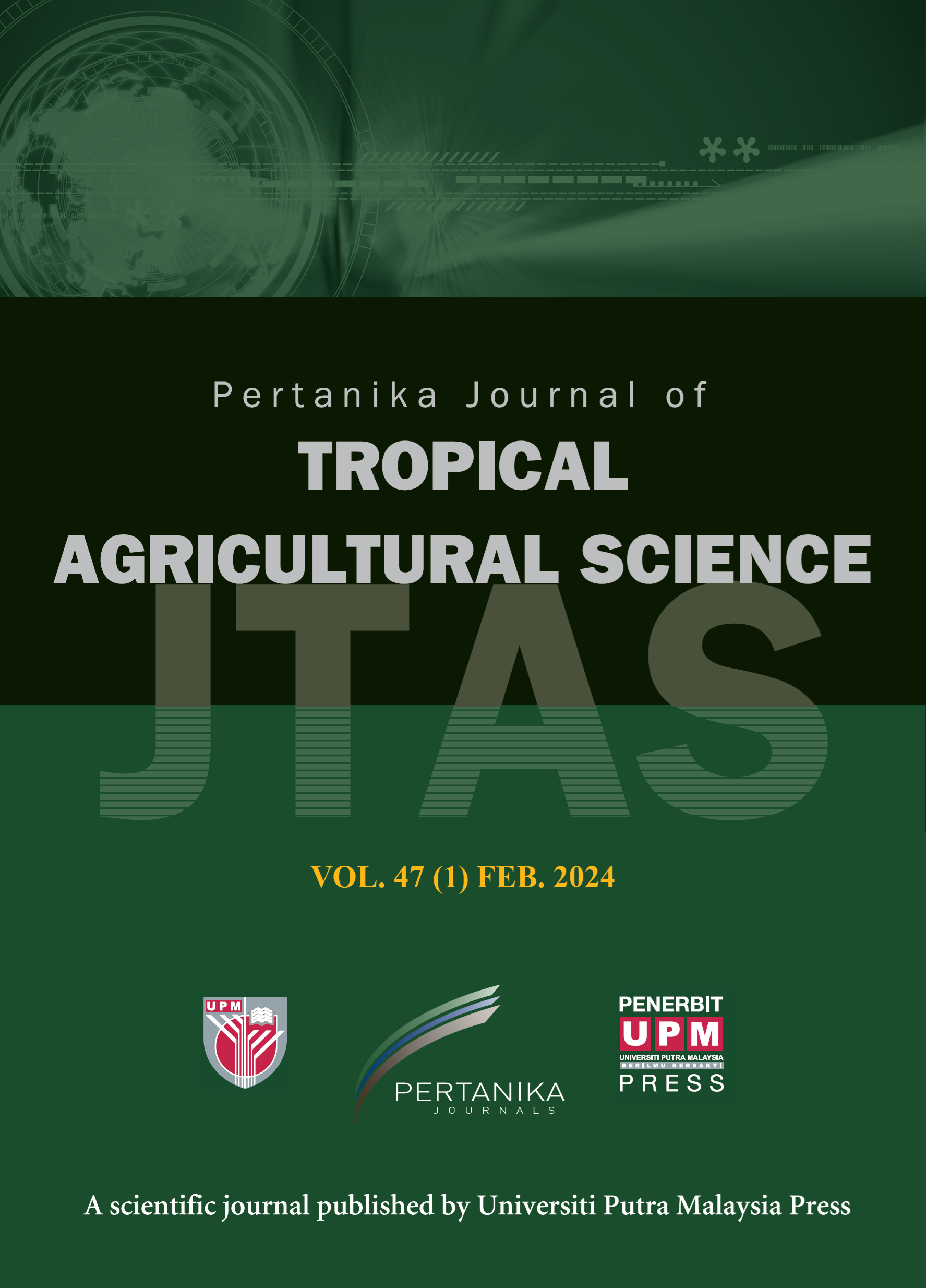PERTANIKA JOURNAL OF TROPICAL AGRICULTURAL SCIENCE
e-ISSN 2231-8542
ISSN 1511-3701
J
J
Pertanika Journal of Tropical Agricultural Science, Volume J, Issue J, January J
Keywords: J
Published on: J
J
-
Àlvarez, E., & Barba, E. (2008). Nest quality in relation to adult bird condition and its impact on reproduction in Great Tits Parus major. Acta Ornithology, 43(1), 3-9. https://doi.org/10.3161/000164508x345275
-
Baveja, P., Tang, Q., Lee, J. G. H., & Rheindt, F. E. (2019). Impact of genomic leakage on the conservation of the endangered Milky Stork. Biological Conservation, 229, 59-66. https://doi.org/10.1016/j.biocon.2018.11.009
-
BirdLife International. (2020). Species factsheet: Mycteria leucocephala. http://www.birdlife.org
-
Daud, U. N. S., Ismail, N. A., Nor, S. M., & Mansor, M. S. (2022). Biparental incubation behavior in the domestic house-farmed swiftlets (Aerodramus sp.) in central Peninsular Malaysia. Animal Biology, 72(1), 39-49. https://doi.org/10.1163/15707563-bja10066
-
Hancock, J., Kushlan, J. A., & Kahl, M. P. (2010). Storks, ibises and spoonbills of the world. A&C Black.
-
Heenan, C. B., & Seymour, R. S. (2011). Structural support, not insulation, is the primary driver for avian cup-shaped nest design. Proceedings of the Royal Society B: Biological Sciences, 278(1720), 2924-2929. https://doi.org/10.1098/rspb.2010.2798
-
Ismail, A., & Rahman, F. (2013). Does weather play an important role in the early nesting activity of colonial waterbirds? A case study in Putrajaya Wetlands, Malaysia. Tropical Life Sciences Research, 24(1), 1-7.
-
Jovani, R., & Tella, J. L. (2004). Age-related environmental sensitivity and weather mediated nestling mortality in White Stork Ciconia ciconia. Ecography, 27(5), 611-618. https://doi.org/10.1111/j.0906-7590.2004.03925.x
-
Kalam, A., & Urfi, A. J. (2008). Foraging behaviour and prey size of the Painted Stork. Journal of Zoology, 274(2), 198-204. https://doi.org/10.1111/j.1469-7998.2007.00374.x.
-
Kaluthota, C. D., Gamage, S. N., & Kaluthota, U. L. S. (2005, December 2-3). Breeding status of the Painted Stork (Mycteria leucocephala) in the Kumana villu of the Yala East National Park. In Proceedings of International Forestry and Environment Symposium. Kabool Lanka, Thulhiriya, Sri Lanka
-
Korpimäki, E. (1985). Clutch size and breeding success in relation to nest-box size in Tengmalm’s owl Aegolius funereus. Ecography, 8(3), 175-180. https://doi.org/10.1111/J.1600-0587.1985.TB01168.X
-
Lambrechts, M. M., Aimé, C., Midamegbe, A., Galan, M. J., Perret, P., & Grégoire, A. (2012). Nest size and breeding success in first and replacement clutches: An experimental study in Blue Tits Cyanistes caeruleus. Journal of Ornithology, 153(1), 173-179. https://doi.org/10.1007/s10336-011-0722-1
-
Mansor, M. S., & Ramli, R. (2017). Niche separation in flycatcher-like species in the lowland rainforests of Malaysia. Behavioural Processes, 140, 121-126. https://doi.org/10.1016/j.beproc.2017.04.010
-
Mansor, M. S., Nor, S. M., & Ramli, R. (2020). Shifts in foraging behaviour of heterospecific flocking birds in a lowland Malaysian rainforest. Behavioural Processes, 180, Article 104229. https://doi.org/10.1016/j.beproc.2020.104229
-
Mansor, M. S., Ramli, R., & Sah, S. A. M. (2015). The foraging tactics of Chestnut-winged babbler (Stachyris erythroptera) and Abbott’s babbler (Malacocincla abbotti) in a lowland rainforest, Malaysia. Sains Malaysiana, 44(5), 687-692. https://doi.org/10.17576/jsm-2015-4405-07
-
Meganathan, T., & Urfi, A. J. (2009). Inter-colony variations in nesting ecology of Painted Stork (Mycteria leucocephala) in the Delhi Zoo (North India). Waterbird, 32(2), 352-356. https://doi.org/10.1675/063.032.0216
-
Murray, C. G., & Hamilton, A. J. (2010). Perspectives on wastewater treatment wetlands and waterbird conservation. Journal of Applied Ecology, 47, 976-985. https://doi.org/10.1111/j.1365-2664.2010.01853.x
-
Novoa, C., Besnard, A., Brenot, J. F., & Ellison, L. N. (2008). Effect of weather on reproductive rate of Rock Ptarmigan Lagopusmuta in the eastern Pyrenees. Ibis, 150(2), 270-278. https://doi.org/10.1111/j.1474-919X.2007.00771.x.
-
Prabhakar, C. S., & Dudhmal, D. (2016). Painted Stork (Mycteria leucocephala): Population status, shift in food and behavioral ecology from isolated ponds of Godavari River basin in Nanded district, India. Science Research Reporter, 6(1), 50-57.
-
Slagsvold, T. (1989). On the evolution of clutch size and nest size in passerine birds. Oecologia, 79(3), 300-305. https://doi.org/10.1007/BF00384308.
-
Sparks, T. H., & Tryjanowski, P. (2005). The detection of climate impacts: Some methodological considerations. International Journal of Climatology, 25(2), 271-277. https://doi.org/10.1002/joc.1136
-
Urfi, A. J, Meganathan, T., & Kalam, A. (2007). Nesting ecology of Painted Stork (Mycteria leucocephala) at Sultanpur National Park (Haryana), India. Forktail, 23, 150-153.
-
Urfi, A. J. (2010). Factors causing nest losses in the Painted Stork Mycteria leucocephala: A review of some Indian studies. Journal of the Bombay Natural History Society, 107, 55-58.
-
Urfi, A. J. (2011a). Storks and humans. In A. J. Urfi (Ed.), The Painted Stork (pp. 121-130). Springer. https://doi.org/10.1007/978-1-4419-8468-5_7
-
Urfi, A. J. (2011b). The Painted Stork: Ecology and Conservation. Springer.
-
Urfi, A. J., & Kalam, A. (2006). Sexual size dimorphism and mating pattern in the Painted Stork (Mycteria leucocephala). Waterbirds, 29(4), 489-496. https://10.1675/1524 4695(2006)29[489:SSDAMP]2.0.CO;2
-
Vergara, P., Gordo, O., & Aguirre, J. I. (2010). Nest size, nest building behaviour and breeding success in a species with nest reuse: The white stork Ciconia ciconia. Annales Zoologici Fennici, 47(3), 184-194. https://doi.org/10.5735/086.047.0303
-
Yee, E. Y. S., Zainuddin, Z. Z., Ismail, A., Yap, C. K., & Tan, S. G. (2013). Identification of hybrids of Painted and Milky Storks using FTA card-collected blood, molecular markers, and morphologies. Biochemical Genetics, 51(9-10), 789-799. https://doi.org/10.1007/s10528-013-9607-8.
-
Zakaria, M. A., & Nor, S. M. (2019). Population estimates of painted stork (Mycteria leucocephala) in three main breeding sites Peninsular Malaysia. AIP Conference Proceedings, 2111, 060005. https://doi.org/10.1063/1.5111267
ISSN 1511-3701
e-ISSN 2231-8542




